I was brought up in Pennsylvania in an independent Bible Church. Our church building was a large auditorium designed for people to listen to Bible-based sermons. At the front was a big central pulpit and behind the preacher were some pews for the choir. Behind the choir was a recessed baptismal pool, and on the wall behind the pool was a large empty cross. In the church building there were no stained glass windows. There were no Stations of the Cross. There were no flowers. There were no candles. There were no statues of saints.
After college I had the chance to travel and I visited both Europe and India. In France I went into a Catholic cathedral for the first time. As I stepped into the cathedral of Notre Dame in Paris, the interior was dark due to the deep colours of the stained glass windows. Amidst the musty antiquity I could smell the faint fragrance of incense and flowers. Little side chapels dedicated to various saints broke up the vast space of the interior. I went into one and saw in the shadows, the statue of a woman high above an altar. She was dressed in blue, wore a crown and held a child. Beneath her feet a serpent writhed in terror. On and around the altar were vases full of flowers. Banks of candles guttered in the darkness, and when I looked around I saw that there were two or three old women kneeling in prayer, gazing up at the statue of Mary.
When I went to India a few years after that I visited a Hindu temple. Like the Catholic cathedral, inside the temple was an altar before a statue. Offerings of flowers were everywhere. Joss sticks of incense and rows of oil lamps burnt before the image of the pagan god. All around people knelt or stood in prayer.
Coming from my background both Catholicism and Hinduism seemed equally foreign. In fact, Catholicism seemed to be more similar to the pagan Hinduism than it did to my form of Christianity. I remembered the lurid and sensational Chick tracts I’d read as a child and could have concluded that Catholicism really was just as pagan as it’s Protestant critics made out.
Similarity and Same-ness
I could have made that conclusion, but I didn’t, because by the time I was travelling I was already an Anglican. I was studying theology in England and had come to accept that Catholic forms of Christianity were authentic. In visiting the medieval churches and cathedrals of Europe I couldn’t help but be struck by the beauty, antiquity and power of the Christian art on display. But the visit to India also made me aware of how very different Christianity is from Hinduism.
That might seem strange because the visit to the Hindu Temple and the Catholic cathedral actually revealed the similarities between the two religions. Both the cathedral and the temple had statues on display for devotional purposes. In both the temple and the cathedral there was an altar placed in front of the statue. In both of them people were lighting candles in front of the statues. In both of them people placed offerings of flowers in front of the statues. Both groups both of people were praying in front of the statues. Mustn’t we conclude that both groups of people were, in fact, praying to the statues? Weren’t both groups worshipping idols?
Its true that there are similarities between Catholic worship and pagan worship. But that’s what you would expect isn’t it? They’re both world religions, and people do the same kind of religious things no matter what their religion. We don’t throw out elements of Christianity just because the same elements happen to exist in other religions. If we eliminated everything that was similar to other religions we would have to throw out Scripture and cancel our Bible studies because Muslims, Jews, Hindus and Buddhists also have Holy Scriptures and spend time studying their Holy Books.
Just because two things are similar it doesn’t mean they’re the same, or that they’ve come from the same place, or that they’re headed in the same direction. To say that Catholicism is the same as paganism just because there are some things that look similar is like saying a Cadillac and a Corvette are the same thing. It’s true that they’re both cars, and there are many similarities between them. Both Cadillacs and Corvettes have glove compartments, exhaust pipes, four wheels and a trunk. But the Cadillac and the Corvette are also very different. It’s the same between pagan worship and Catholic worship. They have similarities, but they also have very important differences.
Saints and Monsters
Look more closely at the two kinds of statues. The Hindu statues are strange and frightening. Some of the pagan gods are nice—like the cheerful, blue skinned god Krishna. Some are cute like Ganesh, the elephant god. But more often the Hindu god is a beast of some kind. It is likely to have the body of a man and the head of a monster or a monkey. The Hindu statue might be a representation of the goddess Kali—a fearsome demon with eight arms. She is black, with a blood red tongue stuck out, and she wears a necklace of skulls. Consider the ancient pagan gods of Babylon, Egypt or Caanan. They are nightmarish hybrids — Wolf-men, bull-men, falcon-men. Think of the idols of primitive tribes: they are gruesome, bewildering and bizarre, and although the pagan statues represent ‘gods’ we know they actually represent those fallen spiritual beings otherwise known as demons.
Now look again at the statues in a Catholic Church. They simply are not the same thing at all. These are the images of real people. There’s Joseph the carpenter from Nazareth. There’s Mary, his wife. There is Francis, the beggar saint from Assissi, and over there is Theresa—the teenaged French nun looking like the fresh faced girl next door. Look, there is Peter, stern and brave, and over there is Anthony—ready to preach the word. These are not images of fearful demonic beings who demand your worship. These are not frightening demi-gods who will devour you if you do not please them. These are images of ordinary people who have become extraordinary because they have given everything to God. These are God’s advertisements for a special free gift called grace. These are our friends, our mentors and our role models. These images are more like a family portrait gallery than a chamber of horrors full of demonic gods and goddesses.
Comparing the two types of statues makes us realise that the differences between two types of religion are more important than their similarities. The pagan images are images from hell. The Christian images are images from heaven. The pagan images portray demons who set themselves up as false gods. The Christian images portray saints who worship around the throne of the one true God. The pagan images are gruesome. The Christian images are awesome. The pagan gods are the fallen beings of the underworld. The Christian saints are those who have been raised up to the highest heights.
No Graven Images
Some years ago I was poking around a medieval church in England with an Evangelical friend named Tom. We were both interested in the dusty old history of the place. I was caught up in the sense of holiness in the ancient house of prayer, but I sensed that my friend was not totally happy. Suddenly Tom stopped and pointed with a snort of dismay. Over the door he had spotted a carved medieval image of St Michael battling the devil.
‘What’s wrong?’ I asked.
‘Second commandment’ he said.
‘What?’
‘Thou shalt not make unto yourself any graven image.’
Immediately he left the church and refused to visit any more of these temples for idols.
Can the Old Testament commandment, ‘Thou shalt not make any graven images’ really mean that no images are allowed in churches at all? Its impossible that this is the true meaning of that commandment since later on in the Book of Exodus God actually commands Moses to make a graven image for worship. In Exodus 25.18-20 Moses is told to make two great cherubim out of wood. They are to be covered with gold and placed over the Ark of the Covenant. In Exodus 26.31 the veil in the tabernacle is meant to woven with images of cherubim and in Numbers 21.8-9 God commands Moses to make a bronze serpent so that the people, who were smitten with snakebite, might look on it and live. Furthermore, when you read about the temple that Solomon built, there are beautiful and powerful images all over the place. The great basin to wash the sacrifices sits on the back of twelve bronze bulls, (2 Chronicles 4.4) images of cherubim were woven into the veils of the temple (2 Chronicles 3.14) and magnificent statues of cherubim were made for the Holy of Holies (2 Chronicles 3.10-13)
According to the Bible itself, the commandment against graven images is not a blanket condemnation of all religious images. Instead the second commandment (according to non-Catholics) is a commandment against two things. Most importantly, it is linked with the first commandment that the Hebrews are to have only one God. That’s why Catholics read the two commandments together. The law to have just one God is the most important part of this first commandment. All the other cultures around the Jews were polytheistic. They worshipped a whole range of gods. The first commandment to the Jews is the simple one that, despite all the cultural pressure, they were to worship only the Lord. The second reason for the commandment against graven images is, in order to help the Jews focus on their one Lord, all the false idols were to be destroyed. So they wouldn’t fall back into devil worship, they were not to make any new images of demons.
Made in the Image of God
There is an even more profound reason why God told the Jews not to worship images of demons. Not only were images of the demonic beings forbidden, but they were also forbidden to make any images of their own God—the Lord. This is because they were created in the image of God. The astounding truth is that the true image of God was there amongst them in their crude camp in the Sinai desert.
Each of their brothers and sisters was a son or daughter of Adam and Eve, and so each one of them was also created in the image of God. The pagan wolf-men, falcon-men and bull gods were just a lot of bull. They were false gods because the real images of God were real men and women. It took a while for this amazing truth to sink in because, although the Hebrew men and women had been created in the image of God, that image had been terribly wounded and soiled by sin. Nevertheless, God didn’t forbid images because images of God were impossible, but because people had been tempted to look to the wrong images. If we have the wrong answer to a problem sometimes that wrong answer has to be hammered out of us to make room for the right answer. The reason they were not to have images of God was because they were the image of their God—a God who was called Emmanuel—God is with us.
God wanted the Hebrews to be aware that they were created in his image for a very important reason. Each of them were a pointer to an even more marvellous part of God’s plan. This reveals the most amazing reason for the prohibition of false images. False images were outlawed because God wanted the people to look beyond themselves, created things and monster gods for something better. False images of God were banned because the true and perfect image of God was yet to come. From the time of Adam and Eve’s bad decision God was planning for a time when he would send forth his son born of a woman. First he prepared a perfect image of woman in Mary, and when she said ‘yes’ to God the way opened up for the perfect image of God and the image of perfect Man to be revealed for all time.
The Image of the Unseen God
St Paul tells us that Jesus Christ is ‘the image of the unseen God.’ (Col. 1:15) In other words, in Jesus we see what God is really like. The reason images were forbidden in the Old Testament was that God’s intended image was still to come. While graven images of God were forbidden the Old Testament, there were plenty of word pictures of God. The images are rich and abundant. God is portrayed as a Good Shepherd, a Faithful Husband or a Glorious King. God bears the image of a Loving Father, a Suffering Servant, the Powerful Creator or a Heavenly Master. When Jesus comes, the gospels show how he fulfils and completes each one of these Old Testament images of God.
Once Jesus, the true image of God, came to earth images were not only allowed, but necessary. So each image of Jesus Christ reminds us that he is the image of the unseen God. Whether it is in a Crucifix, the Stations of the Cross, an icon of Christ, a mosaic, a painting or a statue of the Sacred Heart of Jesus, each image of the Lord is a reminder that he is the image of the Unseen God. He is God made visible.
Furthermore, if we were originally made in the image of God. Jesus the God-Man has come in order to restore that image to its perfection. St Paul says, ‘Just as we have born the image of the man of dust, we shall also bear the image of the man of heaven.’ (I Cor. 15.49) We are being renewed in knowledge in the image of our creator (Col. 3:10) In other words, ‘we shall be like him.’ (I John 3:2) The purpose of Jesus’ work on earth is not only to redeem us, but to transform us into his likeness. Catholics have images in church not just to be reminded of role models, but to be reminded that our destiny is to be transformed into the likeness of Christ. Each image of a saint in a Catholic Church is a reminder that that real, historical person was transformed by God’s grace to show forth the image of Christ in the world.
Whenever you see a Catholic image therefore, you are really looking at an image of Jesus Christ, for each saint is a window through whom Christ can be seen. Each saint has been transformed into the image of Christ while he is also being made into all that God created him to be. So when you see a statue of the Virgin Mary or Saint Joseph or Saint Anthony in a way you are looking at another version of Jesus because you are looking at a person who has been transformed into a real and living icon of Christ.
Iconoclasm and the 3Ms
‘Iconoclasm’ is a wonderful and scary word. It sounds a bit dangerous– In fact, ‘iconoclasm’ is a dangerous word because it means ‘destruction of the images.’ The iconoclasm controversy in the eighth century saw theologians, emperors, empresses, archbishops and armies fighting over whether or not Christians were allowed to have images in their churches. In the seventh century several forces had made Christians suspicious of physical images. The Monophysites were a group of Christians who de-emphasized the physical aspect of Jesus’ humanity. The Manichaeans were a group of philosophers who thought the physical world was evil. At the same time, in the Eastern Church, the new religion of Mohammedism or Islam, was on the march. These three ‘M’s’ of Monophysitism, Manichaenism and Mohammedism made people conclude that all images were wrong. At one point The Emperor Leo III actually sent in the troops to pull down all the icons and burn them. There were riots. Appeals were made to the Pope, and theologians set about trying to defend the use of icons.
St John of Damascus was the chief among them, and he said, “The apostles saw Christ bodily, his sufferings and his miracles and they heard his words. We are double beings with a body and soul…it is impossible for us to have access to the spiritual without the corporeal, while listening to audible words we hear with our corporeal ears and thus grasp spiritual things. In the same way it is through corporeal seeing that we arrive at spiritual insight.” In other words, “We are physical people and it makes sense for us to have physical worship.” This argument points to an even more profound reason for images in worship.
If we really believe in the incarnation, and if we really believe that ordinary human beings can be transformed into the likeness of Christ, than this transformation actually includes our physical bodies. It is not just our souls that are saved, but all of us. St Paul says, For if we have been united with him in a death like his, we shall certainly be united with him in a resurrection like his. (Rom 6:5) This means our bodies will be transformed and glorified, and if this is true, then it makes sense to have physical images in our churches to remind us of those who have already gone through this real and everlasting transformation.
Eighth Century and Twenty First Century
The arguments hammered out in the Eighth century in Greece are still relevant today. The three “M’s” haven’t died out. There is a trend in both Catholic and Protestant circles to de-emphasize the physical reality of Jesus’ life like the Monophysites did. People may not formally teach that Jesus was not fully human, but they behave like that’s what they believe. They treat Jesus like Superman—a character who looks like a man, but who is really an alien creature with super powers. Others treat Jesus like a squeaky clean miracle working All American boy or they treat him like a radiant God who never really dirtied his feet. Sometimes this tendency portrays Jesus as an otherworldly, poetic, intellectual—a sublime spiritual teacher who was above ordinary passions.
The tendency to de-emphasize Jesus’ physical nature is often combined with a practical kind of Manichean approach to life. When this happens people consider the physical world to be inferior or even sinful. Christians who fall into this error sometimes become obsessively tidy, and consider sexual sins as the only real sin. Their worship becomes overly intellectual or overly ‘spiritual’ with long prayers and academic study. Another form of this fault is excessive tastefulness in religion. Some people have such lofty taste that only the finest architecture will do. Only the most sublime music and liturgy are satisfactory, and they look down their nose at “crude” statues and “common” religious imagery. In fact these spiritual snobs are really looking down on the whole ordinary physical world as being inferior to the intellectual, artistic and spiritual.
At the same time the religion of Islam is still surging forward more strongly than ever. Liked with the other two “M’s” Mohammedism teaches the sinfulness of religious images. It does so because it cannot comprehend that any image of the Lord might be possible. Unlike the other two “M’s” Mohammedism specifically repudiates the incarnation of Jesus Christ, and in doing so, reveals what is actually hidden in the anti-physical approach of Manichaenism and the heresy of Monophysitism.
Taste, Tackiness and True Worship
In the place of these iconoclastic views, Catholics should be unapologetic about our use of images and physical things in worship. The fact that we worship the Lord using physical things is nothing to be ashamed of. God has not created us as purely spiritual beings. We humans are these strange, wonderful and contradictory hybrids of mud and spirit—we are incarnate souls. God gave us bodies to glory in them. The fact that we are physical and spiritual is part of our glory. In fact, there is an old legend that the devil was jealous of Adam because God had made him both spiritual and physical, while the devil, as a fallen angel, was only spiritual.
The fact of the matter is, God gave us physical bodies, and just as a bride says to her husband, ‘With my body I honor thee.’ So we say to our bridegroom, Jesus Christ, “With my body I honor thee.” We honor him when we smell the incense and flowers. We honor him when we see the beauty of magnificent architecture and the tender beauty of a masterwork of sculpture, painting, tapestry or stained glass. We honor him with our ears when we hear the glorious strains of hymn and psalms and spiritual songs. We honor him with our voices as we sing and we honor him with our bodies and as we genuflect or kneel in prayer.
When we venerate an image of Jesus, Mary or the saints in our devotions we are honoring them, but we are also praising the God for the fact that through their physical lives, his glory is revealed. When we use physical images in our worship we are praising God for the physical and glorying in the fact that in Jesus Christ,”the Word became flesh and dwelt among us, full of grace and truth; we have beheld his glory, glory as of the only Son from the Father…and from his fulness have we all received, grace upon grace.
Dwight Longenecker writes from England. His latest book, More Christianity is published by Our Sunday Visitor.

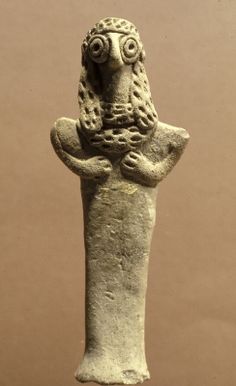
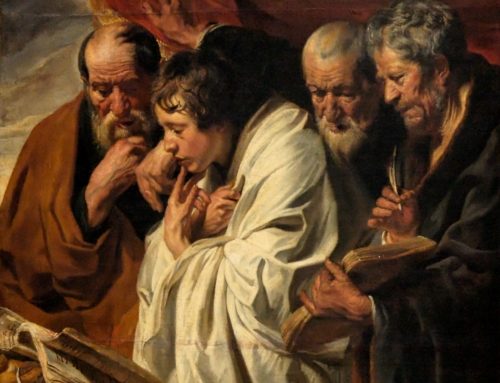
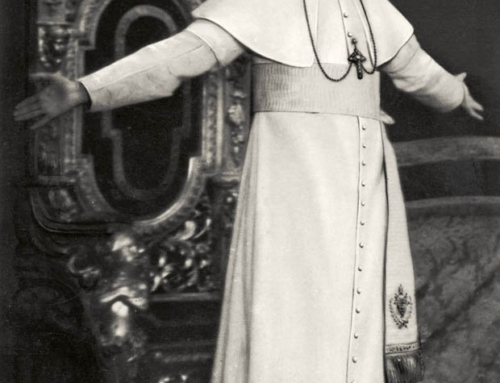
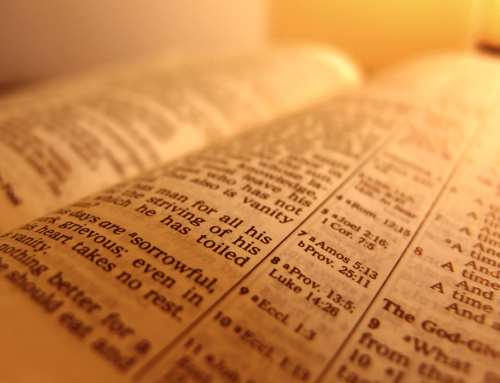
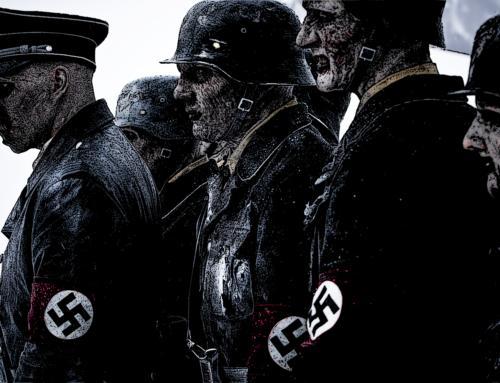
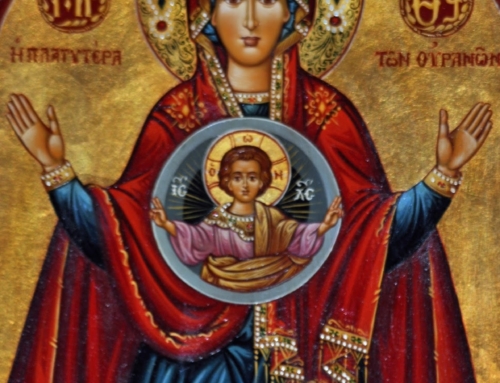
[…] Idol Speculation is in the Apologetics section and answers a common question, “Do Catholics Worship Idols?” […]